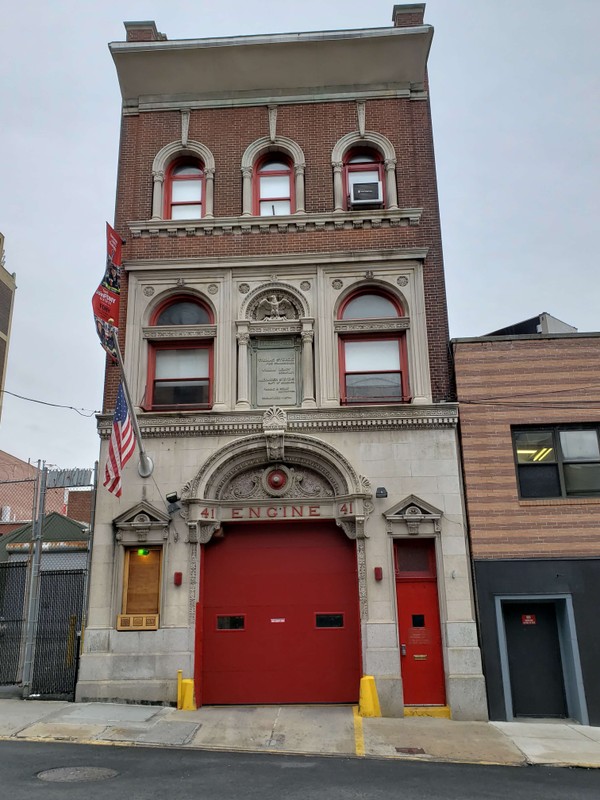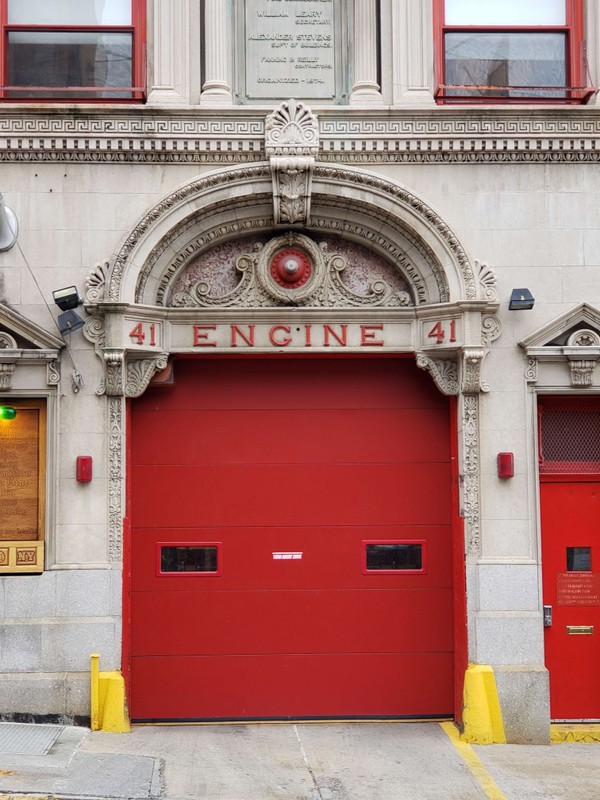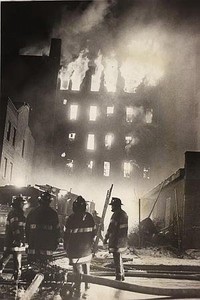FDNY Engine Company/Squad 41
Introduction
Text-to-speech Audio
The Fire Department of New York has a history steeped in tragedies and triumphs. From the great fires that ravaged southern Manhattan in 1835 and 1845 to the Triangle Shirtwaist Factory fire; the numerous labor riots and great arson incidents that plagued the South Bronx during the 1960s and '70's; and most recently September 11, 2001, the Fire Department of New York (FDNY) has answered the call. The same duty to quell destructive infernos, has been heroically carried out time and again by Engine Company/Squad 41. Established over 140 years ago, Engine Company 41 opened at a time when the Bronx had just been annexed to Manhattan. Their initial commission placed the company in the Mott Haven section on Third Street. It was located there until 1903 when the construction of its current residence here on East 150th Street was completed. Engine Company/Squad 41's building is now a New York City landmark.
Images
Engine/Squad 41 (Photographed by the author, 2018)

Close-up view of the Founding Plaque. Engine company 41 was organized in 1874 and moved into the Melrose area of the Bronx after the construction of its new home in 1903. (Photographed by the author, 2018)

The red door distinguishes a Firehouse from civilian residences. (Photographed by the author, 2018)

Firemen fight a blaze in 1970s Bronx. (Vernon Shibla, NY Post)

Abandoned buildings in the Bronx 1970s (Macaulay.cuny.edu).

19th century firefighting apparatus (FDNY)

Backstory and Context
Text-to-speech Audio
The original firefighting organizations in what is now New York City date back to when New York was a Dutch colony. The state mandated all men of age to partake in any firefighting activities as they erupted. This mandate was kept by the English and later the state government in the late 1700s. In 1798 the Fire Department of New York was officially established, in charge of organizing and leading smaller companies in extinguishing municipal fires. The state and city government understood that as cities grew, the potential for life-threatening conflagrations increased as well. These fears would be confirmed in the mid-19th century when two great blazes destroyed and consumed parts of Manhattan. On December 16, 1835, a gas pipe ignited by a stove left unattended began a fire that worked its way around the Wall Street section of the city up and out for at least 17 blocks before being contained and burning itself out. It destroyed close to 700 buildings and $20 million worth of property -- half a billion dollars in today's currency. Zoning codes were implemented to prevent such a catastrophe in the future, such as the construction of brick and mortar buildings. This would later save some property in 1845 when a second fire consumed parts of southern Manhattan. The 1845 fire began in the L. Van Doren Whale Oil Merchant and Candle Manufacture business. The rapidity of its spread prompted the burgeoning fire department to later call for a larger force, resulting in an increase of numerous stations throughout the municipal New York area. In 1865 the New York State Legislature established the Metropolitan Fire District, resulting in a paid firefighting force of close to 5000 men.
As New York City grew in size, its citizens began to move northward, into what was then the suburban areas known as the Bronx and Westchester County. On January 1, 1874, Fire Engine Company 41 was organized and established in the Mott Haven section of the Bronx to serve the residents living there that worked for the various businesses that grew as a result of Jordan L. Mott's Ironworks and other industries attracted by accessibility to the Mott Haven canal. Company 41 served the area in its original home on North Third street, in the building that was originally Jackson Engine Company 4. It stayed there until after the consolidation of the Bronx in 1898, which drew it into the City Beautiful architecture movement of the late-19th century. Arising out of this desire to construct ornamented projects was a civil engineer named Alexander Stevens. He would become the Superintendent of Buildings for the FDNY in 1897 and was responsible for the construction of several firehouses, some of which became historical landmarks. In 1903, he commissioned the firehouse where Company 41 resides to this day. It was landmarked in 2012 for its renaissance revival style and ornate architectural designs consistent with traditional firehouse building of that era.
Engine Company/Squad 41 has endured and prevailed against infernos both physical and sociological. In 1911, Carriage drivers rioted against the mayor and took to the streets causing chaos over low wages and long hours. They rose up and began to attack replacement workers after the drivers decided to go on strike. In Harlem and the South Bronx, violence and vandalism was especially prevalent, at one point prompting firemen of 41 to call local police reserves when they witnessed certain rioters attacking other drivers collecting street garbage cans. In 1921, John R. Shelton of Company 41 picked up police officers in a vehicle and successfully chased down and assisted in the capture of bandits with $45,000 worth of silk (about $600k today). Yet the biggest challenges that 41 would face came during significant changes in their local communities.
After World War 2, an influx of African American and Puerto Rican people moved into the Bronx, specifically in areas that at one time were predominantly middle-class and white. In 1940, only 1% of the Bronx had an African-American population. By 1970, it had jumped to 25% African-American and 28% Latino (mostly Puerto Rican). The discrimination in housing and loaning practices, along with language barriers and lack of jobs resulted in the Melrose area of the Bronx being deprived of community support services from both the city government and private development sectors. As a result, buildings were left to rot by landlords and eventually abandoned. Some of them were set on fire for insurance claims while others burned because of simple faults in electrical wiring. The firemen of Company 41 were on call again and again as an estimated 40% of the South Bronx was burned between 1970 and 1980. They not only dealt with the perpetual inferno night after night, but they suffered attacks, as well, from residents who hated any form of government staff that resembled authority. In 1968, there was a spate of attacks on fire companies throughout the city, where 700 false alarms had been called. There were reports of bricks being launched at department vehicles and young kids spitting at them when they disembarked to fight a blaze. Yet in spite of the hostile environment, Company 41 maintained its resolve, and continued saving lives and fighting fires.
In 1989, Mayor Ed Koch decided to cut back on fire departments throughout New York City, and 41 was amongst the companies that was decommissioned. This led to protests within the Melrose community, which recognized the service rendered by Company 41 and its history. Protestors eventually triumphed and the century-old firehouse reopened in July 1990. Thereafter, the firehouse was recommissioned as a Squad Company, specialists who are trained to deal in Hazardous Materials and even marine operations. Their doors were kept open to build upon the century of traditions and sacrifices.
Not far into the 21st century the level of sacrifice made by Company 41 -- so characteristic of their organization -- was evident again. On September 11, 2001, the World Trade Center in Lower Manhattan was struck by two passenger jets, causing the twin towers that composed the World Trade Center to eventually collapse. Among the 2600 lives lost that day in the city, 6 of them were the brave and courageous men of Fire Engine/Squad 41 who answered the call yet again into one of the most horrific tragedies in American history. Through riots and chaotic destruction of entire blocks of buildings, the fallout from political and social discontent, and modern day unconventional attacks from foreign entities, Fire Engine Company/Squad 41 has stood, ready to be called upon and always answering the call.
As New York City grew in size, its citizens began to move northward, into what was then the suburban areas known as the Bronx and Westchester County. On January 1, 1874, Fire Engine Company 41 was organized and established in the Mott Haven section of the Bronx to serve the residents living there that worked for the various businesses that grew as a result of Jordan L. Mott's Ironworks and other industries attracted by accessibility to the Mott Haven canal. Company 41 served the area in its original home on North Third street, in the building that was originally Jackson Engine Company 4. It stayed there until after the consolidation of the Bronx in 1898, which drew it into the City Beautiful architecture movement of the late-19th century. Arising out of this desire to construct ornamented projects was a civil engineer named Alexander Stevens. He would become the Superintendent of Buildings for the FDNY in 1897 and was responsible for the construction of several firehouses, some of which became historical landmarks. In 1903, he commissioned the firehouse where Company 41 resides to this day. It was landmarked in 2012 for its renaissance revival style and ornate architectural designs consistent with traditional firehouse building of that era.
Engine Company/Squad 41 has endured and prevailed against infernos both physical and sociological. In 1911, Carriage drivers rioted against the mayor and took to the streets causing chaos over low wages and long hours. They rose up and began to attack replacement workers after the drivers decided to go on strike. In Harlem and the South Bronx, violence and vandalism was especially prevalent, at one point prompting firemen of 41 to call local police reserves when they witnessed certain rioters attacking other drivers collecting street garbage cans. In 1921, John R. Shelton of Company 41 picked up police officers in a vehicle and successfully chased down and assisted in the capture of bandits with $45,000 worth of silk (about $600k today). Yet the biggest challenges that 41 would face came during significant changes in their local communities.
After World War 2, an influx of African American and Puerto Rican people moved into the Bronx, specifically in areas that at one time were predominantly middle-class and white. In 1940, only 1% of the Bronx had an African-American population. By 1970, it had jumped to 25% African-American and 28% Latino (mostly Puerto Rican). The discrimination in housing and loaning practices, along with language barriers and lack of jobs resulted in the Melrose area of the Bronx being deprived of community support services from both the city government and private development sectors. As a result, buildings were left to rot by landlords and eventually abandoned. Some of them were set on fire for insurance claims while others burned because of simple faults in electrical wiring. The firemen of Company 41 were on call again and again as an estimated 40% of the South Bronx was burned between 1970 and 1980. They not only dealt with the perpetual inferno night after night, but they suffered attacks, as well, from residents who hated any form of government staff that resembled authority. In 1968, there was a spate of attacks on fire companies throughout the city, where 700 false alarms had been called. There were reports of bricks being launched at department vehicles and young kids spitting at them when they disembarked to fight a blaze. Yet in spite of the hostile environment, Company 41 maintained its resolve, and continued saving lives and fighting fires.
In 1989, Mayor Ed Koch decided to cut back on fire departments throughout New York City, and 41 was amongst the companies that was decommissioned. This led to protests within the Melrose community, which recognized the service rendered by Company 41 and its history. Protestors eventually triumphed and the century-old firehouse reopened in July 1990. Thereafter, the firehouse was recommissioned as a Squad Company, specialists who are trained to deal in Hazardous Materials and even marine operations. Their doors were kept open to build upon the century of traditions and sacrifices.
Not far into the 21st century the level of sacrifice made by Company 41 -- so characteristic of their organization -- was evident again. On September 11, 2001, the World Trade Center in Lower Manhattan was struck by two passenger jets, causing the twin towers that composed the World Trade Center to eventually collapse. Among the 2600 lives lost that day in the city, 6 of them were the brave and courageous men of Fire Engine/Squad 41 who answered the call yet again into one of the most horrific tragedies in American history. Through riots and chaotic destruction of entire blocks of buildings, the fallout from political and social discontent, and modern day unconventional attacks from foreign entities, Fire Engine Company/Squad 41 has stood, ready to be called upon and always answering the call.
Sources
Kurshun, Virginia. "FireHouse, Engine Company/Squad 41." Landmarks Preservation Commission, ser. 2521, vol. 456, 1-8. Published June 12, 2012. http://www.neighborhoodpreservationcenter.org/db/bb_files/2012-Firehouse--Engine-Company-41.pdf.
Goldberg, Merle. "Firemen Under Fire." The New Yorker. The New Yorker November 04, 1968: 31-33.
Butterfield, Fox. Where the Bronx Burned, A fight for a Firehouse. New York Times: June 29, 1988. Accessed April 08, 2018. https://www.nytimes.com/1988/06/29/nyregion/where-the-bronx-burned-a-fight-for-a-firehouse.html.
"Strikers in Riots; One Man is Killed." The New York - Tribune (New York) November 11, 1911. , 1-2.
Bandits Caught in Flight with $45,000 in Silk. ProQuest. July 30, 1921. Accessed April 04, 2018. https://search-proquest-com..
Triangle Shirtwaist Factory Fire. History. January 01, 2009. Accessed April 18, 2018. https://www.history.com/topics/triangle-shirtwaist-fire.
New York Daily Tribune July 21, 1845. Chronicling America. July 21, 1845. Accessed April 10, 2018. https://chroniclingamerica.loc.gov/lccn/sn83030213/1845-07-21/ed-1/seq-2/.
Goldberg, Merle. "Firemen Under Fire." The New Yorker. The New Yorker November 04, 1968: 31-33.
Butterfield, Fox. Where the Bronx Burned, A fight for a Firehouse. New York Times: June 29, 1988. Accessed April 08, 2018. https://www.nytimes.com/1988/06/29/nyregion/where-the-bronx-burned-a-fight-for-a-firehouse.html.
"Strikers in Riots; One Man is Killed." The New York - Tribune (New York) November 11, 1911. , 1-2.
Bandits Caught in Flight with $45,000 in Silk. ProQuest. July 30, 1921. Accessed April 04, 2018. https://search-proquest-com..
Triangle Shirtwaist Factory Fire. History. January 01, 2009. Accessed April 18, 2018. https://www.history.com/topics/triangle-shirtwaist-fire.
New York Daily Tribune July 21, 1845. Chronicling America. July 21, 1845. Accessed April 10, 2018. https://chroniclingamerica.loc.gov/lccn/sn83030213/1845-07-21/ed-1/seq-2/.
